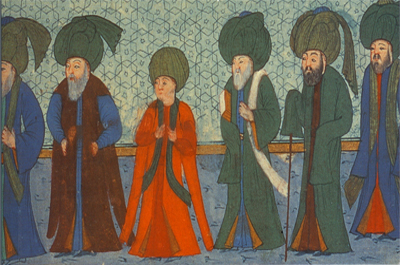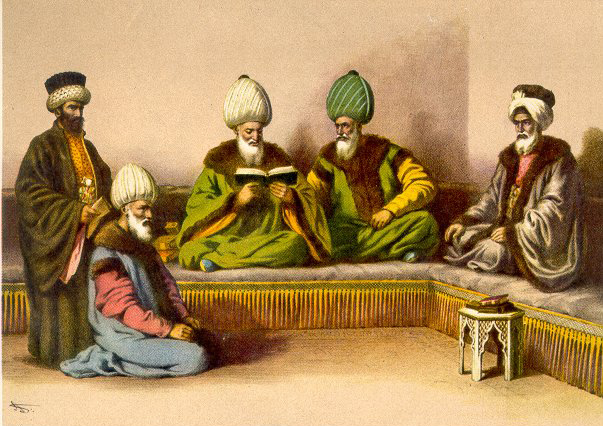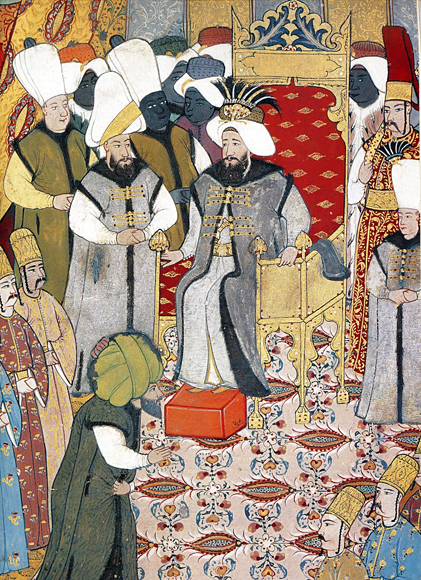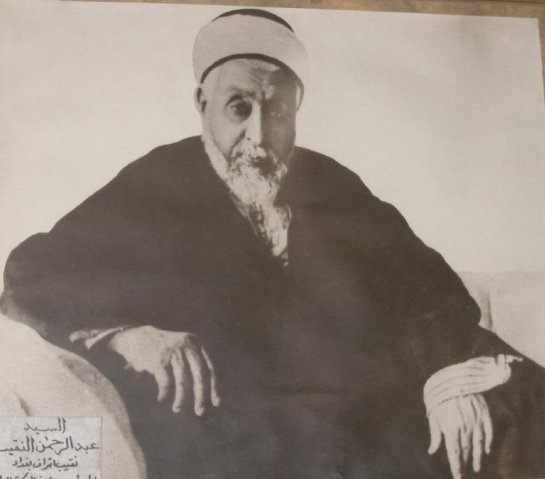(1).jpg)
SULTANS WOULD STAND UP FOR THE HEAD OF THE PROPHET'S LINEAGE
The Ottomans showed to the descendants of the Prophet a respect and affection unmatched elsewhere; they performed every service necessary for them to live in comfort and peace.The lineage of the Prophet Muhammad continued through his daughter, Fatimah al-Zahra. After the 3rd and 4th centuries of the Hijri calendar, the number of those descending from Fatimah’s sons, Hasan ibn Ali and Husayn ibn Ali, increased. Children born from this lineage began to be registered before a judge in the presence of two witnesses. During the time of the Abbasid Caliph al-Mutawakkil (847–861), a separate naqib (chief/head) was appointed to oversee the personal affairs of the descendants of Ali ibn Abi Talib and Abbas ibn Abd al-Muttalib. Sometimes both were combined in a single person. Ambassadors were generally chosen from among the naqibs. Caliph al-Ma’mun instituted the custom that descendants of the Prophet should dress in the blessed green color so that they could easily be distinguished from the general populace. The Mamluks also gave the title “sharif” to the descendants of Hasan, and “sayyid” to the descendants of Husayn.

Privileged Class
The institution of naqib continued in the Fatimid, Seljuk, Zengid, Ayyubid, and Ilkhanid states, which inherited from the Abbasids. The word naqib in Arabic comes from the root naqb, meaning to pierce through, open a way, or make a passage through a mountain; and it means a representative of a community. In the Qur’an, it is told that the Prophet Musa (Moses) appointed a naqib for each of the twelve tribes of the Children of Israel. The Prophet Muhammad also appointed naqibs from among the people of Medina.
.jpg)
In order to prevent outsiders from mixing among them, and to ensure that if a person from this lineage traveled he would not be deprived of the respect due to him, Sultan Bayezid I established an office called nazır (overseer). To this position was appointed Seyyid Ali Natta’, a Baghdadi who had come to Anatolia with Emir Sultan. For a time, this office remained vacant. During the reign of Sultan Bayezid II, Seyyid Mahmud, a student of the sultan’s teacher Molla Abdullah of Crimea, who had come from Egypt to Istanbul, was appointed to this office in 1494. Seyyid Mahmud had seen that in Egypt this office was called naqib al-ashraf (naqib of the noble descendants). The Ottomans, for the sake of continuing tradition, also adopted this title.

The Ottoman sultans showed to the sadat (descendants of the Prophet, i.e., sayyids and sharifs) a love and respect unmatched elsewhere; they performed every service necessary for them to live in comfort and peace. By exempting them from taxes, and giving them in their hands a siyadat barat (certificate of nobility), they provided official documentation. For this reason, many began to claim belonging to this lineage, and when they started registering their genealogy in court with two witnesses, the number of this privileged class increased; although general inspections were sometimes carried out, the matter could not be fully controlled. After the Tanzimat period, the registration procedure was no longer emphasized; and even those not belonging to this lineage introduced themselves as sharifs and sayyids.
The Sultan Would Stand Up
The naqib al-ashraf kept the registry of the sharifs and sayyids in the land. To those proven to descend from this lineage, he would issue a religious document called siyadat hujjah. He would struggle against the mutasayyids (those falsely claiming to be sayyids). He would prevent sayyids whose behavior was unbefitting their dignity. He distributed their share of the war booty. He prevented the daughters of the sadat from marrying men who were not their equals. He adjudicated disputes among them; indeed, he even had a private prison in his residence for sayyids and sharifs who committed crimes. No one other than the sadat was allowed to wear a green turban.

The naqib al-ashraf was chosen by the sultan from among the sadat, being mild, gentle, pious, God-fearing scholars. In the early periods, like other members of the learned class, naqibs did not receive a salary; they performed this duty voluntarily. Although the first naqib, Seyyid Ali, was given the administration of the Ishaqiye Waqf (Islamic foundation) in Bursa, he preferred to earn his livelihood through his actual profession of quilt-making. During the reign of Sultan Bayezid II, the naqib al-ashraf was given a salary equal to that of the high judges.

When a sultan ascended the throne, the naqib al-ashraf was the first to pledge allegiance (biat) for blessing (considered auspicious); sometimes he girded them with the sword (a symbolic ceremony). In general, the supplications (‘dua’s) during ceremonies were also made by the naqib al-ashraf. When the imperial army set out on campaign, the naqib al-ashraf also participated, and the the sacred banner (Liwa’ al-Sharif) was entrusted to him. Sultan Abdulhamid II allocated a mansion near the Yıldız Palace to the naqib al-ashrafs. Although not part of the state dignitaries, the naqib al-ashraf was always placed in the foremost position in every ceremony; he was shown respect in protocol; and during religious festival greetings and other ceremonies, the sultan would stand up for him.
In the provinces, there were deputies of the naqib al-ashraf. The registers of the naqib al-ashraf, generally kept in Arabic, were called daftar al-sadat (register of descendants), jaridat al-naqib (naqib register), daftar al-sulalah al-tahirah (register of the pure lineage), or daftar al-shajarah al-tayyibah (register of the good tree). Shajarah al-Tayyibah means “blessed tree” and refers to the descendants of the Prophet. Those who lost their certificate (hujjah, popularly called shajara) could apply to the naqib al-ashraf or his deputy, bring two witnesses, prove their sayyidship, and request the renewal of their certificate. More than 70 of these registers have survived to this day.
After the establishment of the Turkish Republic, the office of naqib al-ashraf passed into history. In Türkiye and other Muslim lands, some great and established sadat families chose to take this responsibility upon themselves, appointing an elderly and respected member of the family to this duty.
Önceki Yazılar
-
VIENNA NEVER FORGOT THE TURKS10.12.2025
-
THE FIRST UNIVERSITY IN THE WORLD WAS FOUNDED BY MUSLIMS3.12.2025
-
WHO BETRAYED PROPHET ISA (JESUS)?26.11.2025
-
IT HAS BEEN MORE THAN 100 YEARS SINCE ITS ABOLITION, BUT... IS THE CALIPHATE BEING REESTABLISHED?19.11.2025
-
GREETINGS TO YOU, O OTTOMAN SANJAK!…12.11.2025
-
ROTHSCHILDS BROUGHT THE END OF THE OTTOMAN EMPIRE!5.11.2025
-
SHEIKH BEDREDDIN, SON OF THE QADI OF SIMAVNA29.10.2025
-
THE ROOTS OF THE ENGLISH POLITICIAN IN TURKEY – THE TRAGIC END OF ALI KEMAL BEY22.10.2025
-
WHERE IS THE RED APPLE?15.10.2025
-
THE ABBASIDS IN ANATOLIA1.10.2025